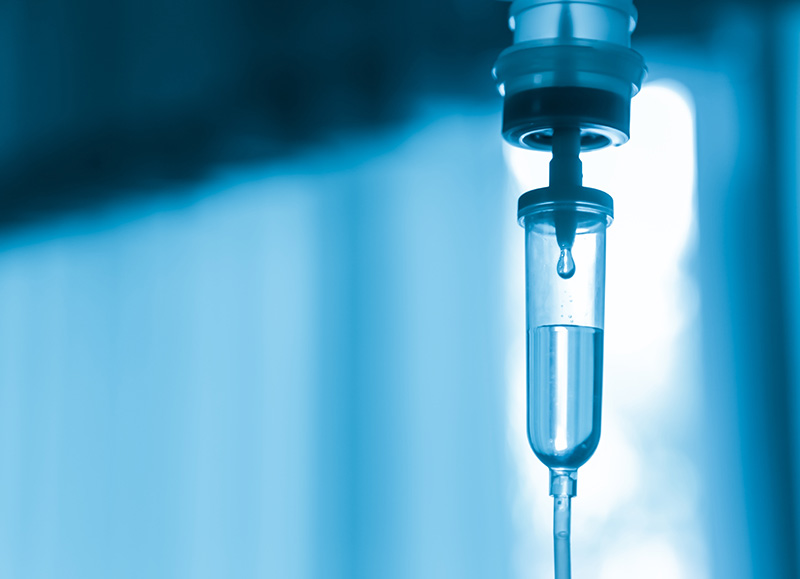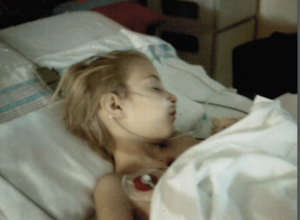
An untold story… Aug 06, 2018

That fateful morning at CHOP
This blog post is the transcript of a talk I gave this past April at the Coalition for Compassionate Care of California 2018 Annual Summit. I was asked to speak to a roomful of 300+ strangers about PTSD, the trauma I experienced undergoing multiple heart surgeries as a young child, and how it has made me into the person, good and bad, I am today.
Writing this fucking sucked, and sharing it is even more difficult for me. These emotions and experiences are things I’ve kept buried my entire life, out of shame, disgust, and fear people would figure me out. 36 years and 364 days of keeping it all a secret, I’m ready to share.
One morning I was resting quietly in bed, I didn’t feel well. The door to my room flew open, startling me out of sleep. In walked a man I didn’t know who was heading towards me. He towered over my tiny frame in the small bed, ripped back the covers and exposed my body. As he leaned down silently, I saw he had something sharp and shiny in his hand. It looked like scissors.
I screamed. I thrashed around trying to push his hands away, but he overpowered me, I watched in horror as scissors came closer. I begged him not to hurt me, screamed for my mom, but he continued towards me with the scissors.
He hurt me. The pain was sharp, piercing. There was pushing, pulling and tugging. The pain of what came next took my breath away. I stopped thrashing and submitted to the pain knowing he would hurt me more if I continued to fight him. Just as quickly as he entered, he abruptly left the room without a word. He never pulled the covers back over my body, leaving me exposed, cold, and distraught.
That was in 1987, while lying in a hospital bed about a week after my 4th heart surgery. The man was a surgical resident, who came in without warning, without saying a word to me, without giving me pain medications or waiting for someone to hold my hand- he found the rare 5 minutes my mom left the bedside for a cup of coffee. He cut and removed staples and sutures from my chest, then pulled out 2 chest tubes. He was so hell-bent on completing the tasks he was surely given by the attending physician, that he didn’t realize a human being, let alone a small child who didn’t understand, was the one in the bed enduring the pain he inflicted.
By the time my mom came back I was carrying on so much that my oxygen levels were dropping; the nurse said she was my mother in an attempt to calm me.
I was 6, not an idiot.
My mom walked in just as I was screaming at the nurse, “You’re not my mommy!” She wrapped her arms around me, told me she was here, but by that point I had disassociated myself from the situation. “You’re not my mommy! My mommy wears ducky slippers!” I screamed, over and over, panicking. She assured me she was my mommy, showed me her slippers that I called her “ducky slippers,” walked around the room so the fabric of them rubbed together making the familiar sound that I loved, and told me that I was OK.
I don’t remember ever feeling less OK.
I could tell dozens of similar stories that I experienced growing up with tetralogy of Fallot, a complex congenital heart defect. At 36, I am part of the first generation of congenital heart defect patients who have not only survived, but thrived into adulthood. Yet only recently have health care professionals studied the physical and psychological repercussions this group of patients have encountered from the trauma we endured since birth.
By the end of 1987 I had four heart surgeries; a BTT shunt, and three open-heart, cardiac catheterizations, and so many chest x-rays that I should be glowing. I’ve gone into cardiac arrest, been intubated without [proper] sedation, and held down more times than I would care to count. I endured all of this before patient-family centered care, before child life specialists, before treatment rooms, and most impressively, without narcotic pain medication. This was all before the development of Dilaudid and Fentanyl, a time before pain was subjective and continuously managed, especially in children.
My cardiothoracic surgeon who performed all 3 open-heart surgeries was Dr William Norwood, inventor of the Norwood Procedure, which today is still the gold standard in the first of 3 surgeries for the treatment of Hypoplastic Left Heart Syndrome. At a time when CT surgeons were not willing to be aggressive in the advancement of surgical therapies for babies born with CHD, Norwood was willing to think outside of the box. He fixed our broken hearts; hearts the size of shrunken plums, and veins slimmer than angel-hair pasta.
In my years as a pediatric cardiac ICU nurse at the Children’s Hospital of Philadelphia, the same hospital I had my surgeries, I worked with nurses who were there in what was called “The Norwood Era.”
I’ve been told repeatedly Dr. Norwood was barbaric, he didn’t allow his patients to be administered pain medications- intra and post-operatively; that the nurses would sneak Tylenol to take the edge off of our suffering.
This is the man who my parents, and many alike, claimed had “Hands of God.” He wouldn’t know me if I walked past him on the street, but his hands have been inside my open chest three times. He rewired and patched my heart back together so I could live. He developed a surgery to buy time for patients who were ALL going to die without it.
It’s where ethical equations get sticky. How much of a learning curve should a doctor- or parents, tolerate, considering the potential payoffs down the road? And at what cost? When it comes to my generation of patients born with CHD, we are just now learning.
The two people who were supposed to protect me, my parents, stood back as perfect strangers poked, probed and hurt me. How could I comprehend that my parents let these things happen with hopes of keeping me alive? They allowed men and women I had never met wheel me down a long hallway while I looked back at them as they cried and held each other. I remember entering the cold, sterile room filled with frightening machines and surgical instruments. I was lifted, naked, onto an operating table, and strapped down. I had taken “giggle juice,” but it did nothing. I was hyper-aware of everything going on around me.
The anesthesiologist asked one of the scrub nurses to take off my nail polish.
I was the picture of bravery- until that poor nurse went to take off my hot pink nail polish my Mom-Mom painted on the night before.
Priorities, people.
I screamed, I yelled, tried to jump off the table, but was held down by the straps. No one takes off my nail polish! I remember the sound of my screams and protests in that operating room. To settle me down, the anesthesiologist promised he would buy me new pink nail polish. I stopped carrying on, and I vividly recall the mask coming down on my face and the smell of the cherry sleeping gas.
I hate cherry.
A single-center study conducted at The Children’s Hospital of Philadelphia (CHOP) found that as many as 1 in 5 adult patients had PTSD symptoms, with about 1 in 10 patients having symptoms directly related to their heart condition. This is the first study to examine the prevalence and correlates of PTSD in the ACHD population.
More than 85% of children born with congenital heart defects now survive into adulthood. Although life expectancy of patients with moderate or severe congenital heart disease has improved, their care is complex, often requiring multiple surgeries and interventional procedures. Currently there are more adults with congenital heart disease than the annual number of babies born with congenital heart disease in the US, despite CHD being the most common birth defect in US.
The study reveals there is a growing population with important unmet needs due to the chronic, lasting effects of the traumatic stress adult CHD patients experienced.
A total of 222 patients were invited to participate in the study, of whom 138 (62%) consented and were enrolled. Four patients were excluded from final analysis, generating a final sample size of 134.
Findings were twofold. First, based on self-report measures, 2 in 10 patients with ACHD met criteria suggestive of PTSD, and 1 in 10 met criteria indicative of PTSD that was specifically related to their underlying CHD, emerged as 2 factors most strongly associated with PTSD.
The prevalence of likely PTSD detected in the cohort of 11% to 21% was found to be several times higher than the 3.5% observed in the general population.
Again, 1987, a few months before the pink nail polish debacle. It was not my best year. Undergoing cardiac catheterization, I felt like I was being stabbed with something in my right leg. I remember my eyes flying open from the pain, and seeing a handful of people standing over me like “oh shit, she’s awake.” I screamed, tried to get up, but every time I sat up at the waist someone slammed by head back onto the operating table. I tried at least 5 more times to get up, but my attempts were feeble.
By the time I was in the PACU, my forehead was swollen and bruised, dried blood on my face, and I had two black eyes- my mom said had it not been for the white blonde hair, she wouldn’t have known it was me. I was unrecognizable. I had woken up mid-procedure, feeling the catheter advancing through my femoral artery. Each time I sat up, my head slammed into the overhead surgical light, and the force threw me back down. The 5th time I smashed my head into the light, I knocked myself out cold.
I was 5 years old, and at most, 40 pounds. Fear certainly gives you super-human strength.
30 years have passed since 1987. The memories are no less intense than when I was actually experiencing it first-hand, and the fear still lingers. I continue to get that fight-or- flight response. I’m suspicious of everyone, thinking at any given moment, they could hurt me, in some way. Some may call that highly aware of my surroundings, but it is so far surpassed that. I get anxious, panicked. Respiratory rate goes up, pupils dilated taking it all in, heart starts pounding, shaking, palms sweaty- and yet, instead of taking myself out of the situation, I can’t move; like all I know is how to wait for the pain and hurt.
Throughout childhood and adolescence, not one person, doctor, nurse, social worker ever sat and asked me how I FELT. Sure, from a cardiac standpoint, I looked great. Pink lips and fingers, no clubbing, no oxygen tanks, no tet spells causing me to drop to a squatting position at any given moment. I was a success.
Until the age of 17, I slept with a night-light. I was terrified of the dark- dark meant death. I can recall having insomnia as early as kindergarten- frightened to go to sleep for fear I would not wake up.
I had this game I would play in my head- if I faced the night light then Dr Norwood could see what he was doing and fix my heart. If I faced away from the night light, I would die. I willed myself to stay awake, fixated on my night light with the red stained-glass cover. Eventually I would drift off to sleep, but the nights I woke at 3am facing away from the night light left me broken.
Childhood and adolescence sucked, there’s no other way to explain. I felt alone, angry, so utterly bewildered at why there was no one else on the planet who had a “broken heart” like me. I was teased and ridiculed relentlessly by my peers; I was small, I couldn’t keep up, I wasn’t allowed to play sports, sometimes I had to attend school wearing a Holter monitor, and kids would yank at the wires to try to rip it off me while teasing me for having a “monkey heart.” I physically developed much more slowly than those around me. If I wore a shirt that showed the [top of my] scar, kids would try to touch it, or point and call me a freak. When I wore shirts that covered the scar, I was taunted for trying to hide the freak show. I couldn’t win, and I felt like a leper. A girl in 6th grade once told me that my “friends” only talked to me because they felt sorry for me.
Going off to college and sharing a dorm room brought on a new level of anxiety- I’m never going to fit in. I’m covered in scars. How would I ever sleep without my night light? How could I make a night light seem cool?
You can’t.
I have a remarkable ability to delete all better judgement from my brain when I get my head set on something. Everything is done at all costs, I have no sense of moderation, no sense of caution. I have no sense, pretty much.
I dove heavily into drinking and drugs. Yes, it’s typical for college freshman to go a bit overboard with his or her newfound freedom; but for me, it was about freedom from the pain. I didn’t care about the detrimental effects drugs and drinking could have on my heart, all I cared about was not feeling anything. I needed to be numb. I did terrible things to my body to try and rid myself of the pain.
Eventually, it wasn’t enough. Slowly but surely, my demons came back with a vengeance- I felt too much, too aware, filled with anger and rage, suspicious that everyone was out to get me.
Imagine feeling like you don’t have control of your own body- that it’s yours, attached to your head, but doesn’t belong to you. That its sole purpose is for someone else to touch, to inspect, to draw blood from, put tubes in, to be a human textbook for a room full of medical students who listen and try to “guess” what is wrong with you, to hold down, to cut, to hurt.
Men are embarrassingly easy to seduce; it felt like a game. Find a cute guy at a party, dance and share a few laughs, then go back to his room and sleep with him. I had power. Control of my body. I called the shots. I was numb, felt nothing, it meant nothing. Make them fall in love with me, and once I knew I could have them, move on. Be in control. Hurt them before they ever had a chance to hurt me.
I don’t know how to have a healthy relationship, intimate or platonic…great line for a dating app! When you think the entire world is out to get you, it’s incredibly difficult to let someone in. I’ve lived my life in a constant state of Defcon 1, calm and happy is not something I do well. I’ve stayed in abusive relationships (physical and emotional) because I didn’t think I deserved better. I yearn for calm and happy, and the moment I find it, the switch flips and I jeopardize it. I don’t feel worthy of calm and happy. I struggle with this every single day of my life.
I’m angry. Angry that none of the people who inflicted all this pain on me never thought to ask how I felt about it.
I’ve been brave for 36 years. It’s my claim to fame. “Oh Marla, how brave you were when that stranger ripped tubes out of your chest and traumatized you for life!”
No one has ever said to me it’s ok to be angry.
This was not easy to write. It was not therapeutic in the least. It was really wrenching to go back and hold up a mirror to how I live and what I believe. This has been deeply painful for me, but I’m sharing it because I want people to know what it really looks like; that it’s not always about being brave and wearing your cape.
And that’s ok.
I’m sure you all can only help but wonder WHY I agreed to get up and share things about my life that, until now, I’ve kept secret from everyone.
I know this was challenging to hear, and may take you some time to process. Hell, I’ve been processing all of this for over 36 years.
It won’t benefit me today, and I’m quite certain I’ll have to gift my therapist a sizable bottle of Irish whiskey after my Friday morning session with her. But YOU can benefit from my story. These conversations are intense and painful; nothing about this is easy for patient or provider. My hope is that patients like me don’t have to live a life of fear. No two people experience things the same, but trauma is trauma, and hard is hard. Support us- let us know you are on our side. Pull the pin, throw the grenade, and have the hard conversation.
Here is the video at the link below, complete with tears, snot, witty quips and one liners (go to 1:06:00 in the recording)


No Comments